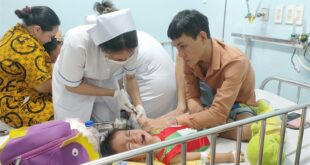 |
| Doctors and nurses at the Hà Nội Obstetrics & Gynaecology Hospital taking care of a pregnant woman. VNA/VNS Photo Minh Đức |
HÀ NỘI Việt Nam is working hard to provide equal health service access for all pregnant women to ensure public health and narrow the socio-economic gap.
This initiative was discussed during a meeting on July 11 in Hà Nội, organised by the Ministry of Health and the United Nations Population Fund (UNFPA) to mark World Population Day 2024.
The event aimed to review global progress in implementing commitments related to sexual and reproductive health and rights and to discuss priorities for addressing outstanding issues amid rapidly changing demographics worldwide, including in Việt Nam.
Đào Hồng Lan, Minister of Health and Standing Deputy Head of the National Committee for Population and Development, emphasised the importance of achieving the goals of Resolution No. 21-NQ/TW of the Party, the Việt Nam Population Strategy to 2030, as well as the Sustainable Development Goals of Việt Nam and the Programme of Action of the International Conference on Population and Development.
To mark World Population Day 2024, the Ministry of Health chose the theme “Investing in Population Work is Investing in Sustainable Development,” calling on all levels, sectors, international organisations, and development partners to continue focusing on and investing in Việt Nam’s population work, contributing to the country’s rapid and sustainable development.
Pauline Fatima Tamesis, UN Resident Coordinator in Việt Nam, stressed the need for urgent and decisive action to ensure that all women have access to essential care services during pregnancy and childbirth. Investing in reproductive and sexual health is an investment in ending poverty and inequality, she said.
In the Asia-Pacific region, the maternal mortality ratio has decreased by 61 per cent since 2000, marking the most significant reduction in recent years. More children are being born with the assistance of skilled health personnel, and the number of adolescents giving birth has nearly halved since 2000. Additionally, 32 countries and territories in the region have conducted at least one survey on gender-based violence.
Over the past 30 years, Việt Nam has made efforts to address inequality and narrow the socioeconomic gap between regions and population groups. The Human Development Index has significantly improved, reaching an average level compared to other countries worldwide. Notable improvements include the reduction in malnutrition and maternal and child mortality rates.
The maternal mortality rate has decreased sixfold over the past 30 years, from 233 per 100,000 live births in 1990 to approximately 40 per 100,000 live births in recent years. Since 1993, the infant mortality rate has dropped from 43.3 to 12.1 per 1,000 live births in 2020. Life expectancy has increased rapidly, from 65.5 years in 1993 to 74.5 years in 2023, exceeding that of many countries with similar average income levels. VNS
- Reduce Hair Loss with PURA D’OR Gold Label Shampoo
- Castor Oil Has Made a “Huge” Difference With Hair and Brow Growth
- Excessive hair loss in men: Signs of illness that cannot be subjective
- Dịch Vụ SEO Website ở Los Angeles, CA: đưa trang web doanh nghiệp bạn lên top Google
- Nails Salon Sierra Madre
 VnExpress News The News Gateway of Vietnam
VnExpress News The News Gateway of Vietnam





